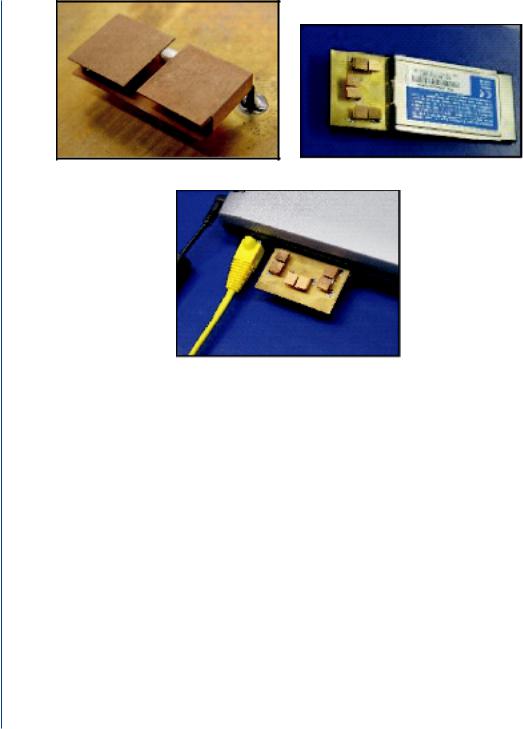
Антенны, СВЧ / OC / Должиков / Introduction to Smart Antennas_Balanis
.pdf
COMMERCIAL AVAILABILITY OF SMART ANTENNAS 153
FIGURE 9.3: The use of standard or custom patterns to fit the topology of sector coverage [228].
swapping out the personality module, the embedded Cell sculpting technology in the systems provides flexibility to change antenna patterns for determination of the optimal in response to the changing RF environment [228]. This technology is the key to enabling operators to shape a cell’s coverage pattern in a way that delivers greater performance, capacity and quality benefits than those of off-the-shelf antennas. Cell sculpting technology takes drive test data and network information to estimate the optimal antenna pattern. The optimal pattern is then transferred to the personality module that is inserted into the back of each antenna panel. Fig. 9.3 illustrates the SmartCell concept.
In complex RF environments without the presence of a dominant server, cell sculpting technology helps increase server dominance in the network to reduce pilot pollution, reduce average transmit power on the forward and reverse link, and reduce variance of transmit power. SmartCell is ideal for complex RF environments where network topology and traffic distributions create difficult radio management challenges. As this changes, operators can make a corresponding change to their antenna patterns. SmartCell technology supports all major air interfaces including CDMA, GSM, TDMA, CDMA2000, and W-CDMA.
Not only smart antennas for cellular systems have come a long way, but also smart antennas for PEDs have made progress. Although their commercial availability has been hindered due to its high costs, research and experiments have shown promising results. A company in Berne, Switzerland, called ASCOM AR&T, has developed a 3-element low power smart antenna for 5–6 GHz W-LAN which is small enough for mobile terminals. The antennas are attached to a PCMCIA card. Each single element is a bent stacked slot antenna which experiences effectively independent fading. Finally, the beamforming is performed at RF frequencies to keep the production costs low. Tests carried out with this product showed a superior performance over an omnidirectional antenna like BluetoothTM [229]. Other experimental projects in the field

154 INTRODUCTION TO SMART ANTENNAS
(a) |
(b) |
(c)
FIGURE 9.4: Smart antenna developed by ASCOM AR&T (a) Single antenna element, (b) PCMCIA card with antenna array, and (c) Smart antenna connected to a Notebook [229].
of smart antennas for W-LANs have also reported similar findings [230, 231]. Fig. 9.4 shows the company’s development.
Finally, it should be stated that as the client’s demand for higher capacity/range in a system grow and the cost of implementing such systems drops due to continual advances in the field, it is expected that the usage of smart antennas will continue to grow.

155
C H A P T E R 10
Summary
This book examined and analyzed various system aspects of a modern communication system based on smart antenna technology. The analysis began with a presentation of the current communication systems with emphasis on their limitations and challenges that need to be resolved in order to meet the continuous increasing demands of high data rates and capacity of the wireless era.
To better understand the smart antenna technology, an entire chapter was devoted to the properties of antenna elements and arrays, and the classification of antennas according to their radiation characteristics. The major analysis of smart antennas was carried out in the chapters that followed where the functional principles of smart antennas were considered, different smart antenna configurations were suggested and the benefits and drawbacks concerning their commercial introduction were stressed. Smart antenna was then examined from the signal processing point of view. In particular, the fundamental properties of the direction of arrival were detailed and this information was exploited in a way to design the array to appropriately shape its radiation pattern. The subsequent chapter presented the results of an effort to integrate various aspects of smart antenna systems, a project that examined antenna design, adaptive beamforming algorithms and their impact on the communication channel BER and network throughput.
Afterward, the unique advantages of joint space–time processing techniques were reviewed and its origins and applications were demonstrated. The chapter was also concerned with the attractive characteristics of MIMO systems, including experimental results, a modern technique that exhibits great promise for large data rates and capacities. Lastly, commercial efforts on smart antennas were briefly summarized. Temporal processing has reached very high levels and has become mature, but by itself is not sufficient. However, when combined with space processing, it may be in a position to meet the ever expanding demands of high speed and reliable communication enjoyed by a constantly increasing population. There is no better verification of this argument than the words of Andrew Viterbi, a pioneer in the global spread of wireless communications, “Spatial processing remains as the most promising, if not the last frontier, in the evolution of multiple access systems” [232].

157
Acknowledgments
The authors would like to express their sincere appreciation for the cooperation, suggestions, generous contributions and supply of information by many of the authors of papers from which material in this paper was derived from and based upon. In particular, the authors would like to recognize: Profs. J. R. Mosig and A. Skrivervik, and their graduate student I. Stevanovic´ from Ecole Polytechnique Fed´erale´ de Lausanne, Switzerland; Profs. R. D. Murch and K. B. Letaief from The Hong Kong University of Science and Technology; Mr. J. Baltersee from Aachen University of Technology, Aachen, Germany; Dr. P. H. Lehne and Dr. M. Pettersen from Telenor Research and Development, Fornebu, Norway; Prof. Steven Blostein and his former students, J. Chou and W. Y. Shiu, from Queen’s University, Kingston, Ontario, Canada; Prof. Arogyaswami Paulraj from Stanford University and Dr. Constantinos Papadias from Bell Labs, Lucent Technologies; Professor A. Lee Swindlehurst from Brigham Young University; Dr. Stefan Werner from Helsinki University of Technology, Finland; Dr. P. Van Rooyen, Founder and CTO of Zyray Wireless, San Diego, CA; Dr. Reinaldo Valenzuela, Dr. Angel Lozano and Dr. Farrokh R. Farrokhi from the Wireless Communications Research Department at Bell Labs, Lucent Technologies; Profs. B. Ottersten and R. Stridh from The Royal Institute of Technology, Stockholm, Sweden; Prof. G. T. Okamoto from Santa Clara University; George Telecki and Brendan Codey, John Wiley and Sons, Interscience Division; and our colleagues Profs. A. S. Spanias, T. M. Duman, and J. M. Capone and graduate students Dr. S. Bellofiore, J. Foutz, R. Govindarajula, and Dr. I. Bahc¸eci at Arizona State University. In advance, we apologize for any omissions; they are not intentional.

159
References
[1]R. D. Murch and K. B. Letaief, “Antenna systems for broadband wireless access,” IEEE Commun. Mag., Apr. 2002.
[2]P. N. Fletcher and P. Darwood, “Beamforming for circular and semicircular array antennas for low-cost wireless LAN data communication systems,” IEEE Proc. Microw. Antennas Propagat., vol. 145, no. 2, pp. 153–158, Apr. 1998. doi:10.1049/ip-map:19981658
[3]J.-A. Tsai and B. D. Woerner, “Adaptive beamforming of uniform circular arrays UCA for wireless CDMA system,” in Record of the Thirty-Fifth Asilomar Conference on Volume Signals, Systems and Computers, vol. 1, Nov. 2001, pp. 399–403. doi:full text
[4]“Smart antenna systems,” International Engineering Consortium. [Online]. Available: www.iec.org/online/tutorials/smart antennas
[5]“Smart antennas,” CDMA Development Group, 2004. [Online]. Available: http://www.cdg.org/technology/cdma technology/smart antennas/index.asp
[6]M. Chryssomallis, “Smart antennas,” IEEE Antennas Propagat. Mag., vol. 42, no. 3, pp. 129–136, June 2000. doi:10.1109/74.848965
[7]S. Andersson, M. Millnert, M. Viberg, and B. Wahlberg, “A study of adaptive arrays for mobile communication systems,” in IEEE International Conference on Acoustics, Speech, and Signal Processing, vol. 5, 1991, pp. 3289–3292.
[8]G. V. Tsoulos, G. E. Athanasiadou, M. A. Beach, and S. C. Swales, Adaptive Antennas for Microcellular and Mixed Cell Environments with DS-CDMA. Netherlands, Kluwer, 1998, ch. 7, Wireless Personal Communications, pp. 147–169.
[9]R. Kohno, “Spatial and temporal communication theory using adaptive antenna array,”
IEEE Personal Commun. Mag., vol. 51, Feb. 1998.
[10]T. S. Rappaport, Smart Antennas Adaptive Arrays, Algorithms, Wireless Position Locations Selected Readings. Piscataway, NJ: IEEE, 1998.
[11]G. V. Tsoulos, Adaptive Antennas for Wireless Communications. Piscataway, NJ: IEEE, 2001.
[12]A. O. Boukalov and S. G. Haggman,¨ “System aspects of smart-antenna technology in cellular wireless communications – an overview,” IEEE Trans. Microw. Theory Tech., vol. 48, no. 6, pp. 919–929, June 2000. doi:10.1109/22.846718

160 INTRODUCTION TO SMART ANTENNAS
[13] J. C. Liberti and T. S. Rappaport, Smart Antennas for Wireless Communications: IS-95 and Third Generation CDMA Applications. Upper Saddle River, NJ: Prentice Hall PTR, 1999.
[14] G. V. Tsoulos, “Smart antennas for mobile communication systems; benefits and challenges, IEEE Commun. Eng. J., vol. 11, no. 2, pp. 84–94, Apr. 1999.
[15] W.-S. Wang, “Bluetooth: A new era of connectivity,” IEEE Microw. Mag., vol. 3, no. 3, pp. 38–42, Sept. 2002. doi:10.1109/MMW.2002.1028360
[16] M. Bravo-Escos, “Networking gets personal,” IEE Rev., vol. 48, no. 1, pp. 32–36, Jan. 2002. doi:10.1049/ir:20020104
[17] S. Bellofiore, “Smart antenna systems for mobile platforms,” Ph.D. dissertation, Arizona State University, Dec. 2002.
[18] E. G. Larsson, P. Stoica, and G. Ganesan, Space–time Block Coding for Wireless Communications. Cambridge: Cambridge University Press, June 2003.
[19] J. Y.-L. Chou, “An investigation on the impact of antenna array geometry on beamforming user capacity,” Master’s thesis, Queen’s University, Kingston, Ontario, Mar. 2002.
[20] I. Stevanovic,´ A. Skrivervik, and J. R. Mosig, “Smart antenna systems for mobile communications,” Ecole Polytechnique Fed´erale´ de Lausanne, Lausanne, Suisse, Tech. Rep., Jan. 2003. [Online]. Available: http://lemawww.epfl.ch
[21] A. Paulraj, B. Ottersten, R. Roy, A. Swindlehurst, G. Xu, and T. Kailath, Subspace Methods for Direction of Arrival Estimation. Amsterdam: North-Holland, 1993, vol. 10, ch. 16, pp. 693–739.
[22] W. Y. Shiu, “Noniterative digital beamforming in CDMA cellular communications systems,” Master’s thesis, Queen’s University, Kingston, Ontario, Nov. 1998.
[23] S. Werner, “Reduced complexity adaptive filtering algorithms with applications to communications systems,” Ph.D. dissertation, Helsinki University of Technology, Helsinki,
Finland, Oct. 2002.
.
[24]S. Bellofiore, J. Foutz, J. Govindarajula, Israfil Bahc¸eci, C. A. Balanis, A. S. Spanias, J. M. Capone, and T. M. Duman, “Smart antenna system analysis, integration and performance for mobile ad-hoc network (MANETs),” IEEE Trans. Antennas Propagat., vol. 50, no. 5, p. 571–581, May 2002.
[25]P. Van Rooyen, “Advances in space–time processing techniques open up mobile apps,” Nov. 2002. [Online]. Available: http://www.eetimes.com/in focus/ mixed signals/OEG20021107S0021
[26]A. J. Paulraj, D. Gesbert, and C. Papadias, Encyclopedia for Electrical Engineering. New York: Wiley, 2000, ch. Antenna arrays for Wireless Communications, pp. 531–563.

REFERENCES 161
[27]A. J. Paulraj and C. B. Papadias, “Space–time processing for wireless communications,” IEEE Signal Process. Mag., vol. 14, no. 6, pp. 49–83, Nov. 1997. doi:10.1109/79.637317
[28]A. Lozano, F. R. Farrokhi, and R. A. Valenzuela, “Lifting the limits on high speed wireless data access using antenna arrays,” IEEE Commun. Mag., vol. 39, no. 9, pp. 156– 162, Sept. 2001. doi:10.1109/35.948420
[29]R. Stridh and B. Ottersten, “Spatial characterization of indoor radio channel measurements at 5 GHz,” in First IEEE Sensor Array and Multichannel Signal Procesing Workshop, Cambridge, Massachusetts, USA, Mar. 2000. [Online]. Available: http://www.s3.kth.se/radio/4GW/public/Papers/RickardStridhSAM2000.pdf
[30]International Telecommunications Union (ITU). [Online]. Available: http:// www.itu.int/home
[31]http://www.wirelessintelligence.com
[32]Alexander Resources. [Online]. Available: http://www.alexanderresources.com/ reports/Report2/Summary.htm
[33]Micrologic Research. [Online]. Available: http://www.mosmicro.com
[34]Micrologic Research. [Online]. Available: http://www.mosmicro.com/Cell Exec.pdf
[35]International Engineering Consortium. [Online]. Available: http://www.iec.org/ online/tutorials/gsm/topic01.html
[36]Qualcomm Corporation. [Online]. Available: http://www.qualcomm.com/cdma
[37]Ericsson. [Online]. Available: http://www.ericsson.com/cdmasystems/3gcdma2000. html
[38]“Air Interface Fundamentals: UMTS and W-CDMA,” Award Solutions. [Online]. Available: http://www.awardsolutions.com/training/elearning pdfs
[39]T. Rappaport, “The wireless communications revolution: Past, present, & future,” Virginia Tech, Tech. Rep., Aug. 1997. [Online]. Available: http://www.mprg.org/ Tech xfer/ppt/vt125th.pdf
[40]L. C. Godara, “Applications of antenna arrays to mobile communications. Part I: Performance improvement, feasibility, and system considerations,” in Proc. IEEE, vol. 85, pp. 1031–1060, July 1997. doi:10.1109/5.611108
[41]P. M. Shankar, Introduction to Wireless Systems. New York: Wiley, 2002.
[42]M. C. Vanderveen, “Estimation of parametric channel models in wireless communications networks,” Ph.D. dissertation, Stanford University, Department of Scientific Computing and Computational Mathematics, Nov. 1997.
[43]J. Baltersee, “Smart Antennas and Space-Time Processing,” Aachen University of Technology, Institute for Integrated Signal Processing Systems, Tech. Rep., May 1998.
[44]V. K. Garg and J. E. Wilkes, Wireless and Personal Communications Systems. Upper Saddle River, NJ: Prentice Hall PTR, 1996.

162INTRODUCTION TO SMART ANTENNAS
[45]“Intellicell: Bringing Wireless to Life,” Arraycomm, 2003. [Online]. Available: http://www.arraycomm.com
[46]B. Pattan, Robust Modulation Methods & Smart Antennas in Wireless Communications. Upper Saddle River, NJ: Prentice Hall PTR, 2000.
[47]T. I. Song, D. J. Kim, and C. H. Cheon, “Optimization of sectorized antenna beam patterns for CDMA2000 systems.” in 3G Mobile Communications Technologies, Conference Publication, No. 471 Third International Conference on 3G Mobile Communication Technologies, 2002. (Conf. Publ. No. 489), May 2002, pp. 428–432.
[48]X. Yang, S. Ghaheri, R. Niri, and R. Tafazzoli, “Sectorization gain in CDMA cellular systems.” in Third International Conference on 3G Mobile Communication Technologies, 2002. (Conf. Publ. No. 489), 2000, pp. 70–75.
[49]T. M. Cover and J. A. Thomas, Elements of Information Theory. New York: WileyInterscience, Aug. 1991.
[50]D. Cox, H. Arnold, and P. Porter, “Universal digital portable communications: A system perspective,” IEEE J. Select. Areas Commun., vol. 5, no. 5, pp. 764–773, June 1987. doi:10.1109/JSAC.1987.1146603
[51]S. Hara and R. Prasad, “Overview of multicarrier CDMA,” IEEE Commun. Mag., vol. 35, pp. 126–133, Dec. 1997. doi:10.1109/35.642841
[52]D. Huff, “Direct Sequence Spread Spectrum Tutorial.” [Online]. Available: www.eas.asu.edu/$\sim$apapand/applet/TF JAVA/applet/DSSS tutorial.doc
[53]W. C. Y. Lee, “Overview of cellular CDMA,” IEEE Trans. Veh. Technol., vol. 40,
pp.291–302, 1991. doi:10.1109/25.289410
[54]M. Engels, Wireless OFDM Systems: How to Make Them Work?, M. Engels, Ed. Dordrecht Kluwer, 2002.
[55][Online]. Available: http://www.wireless.per.nl:202/telelearn/ofdm/
[56]Z. Li, “Performance of multicarrier ds-cdma systems using mutually orthogonal complementary sets of sequences,” University of Florida, Tech. Rep., 2000. [Online]. Available: http://www.tec.ufl.edu/$\sim$zbli/report.pdf
[57]M. Cooper and M. Goldburg, “Intelligent antennas: Spatial division multiple access.” Wireless, Anual. Revw. of Commun., pp. 999–1002, 1996, ArrayComm Inc., San Jose, CA.
[58]C. A. Balanis, “Antenna theory: A review,” in Proc. IEEE, vol. 80, no. 1, Jan. 1992,
pp.7–23. doi:10.1109/5.119564
[59]C. A. Balanis, Antenna Theory: Analysis and Design, 3rd ed. New York: Wiley, 2005.
[60]P.-J. Wan, “Capacity expansion: Sectorized cellular systems.” [Online]. Available: http://www.csam.iit.edu/$\sim$wan/lecture05.pdf
